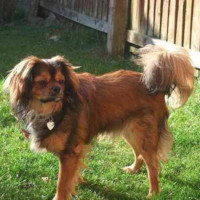Appearance of the King Charles Yorkie
|
| The King Charles Yorkie is a small to medium-sized dog. It's the nature of hybrid dogs that in the same litter, there may be puppies that distinctly resemble a Cavalier or a York, and some are a true mix. The King Charles Yorkie has a slightly rounded skull with a medium-sized muzzle and a black leather nose. Attention is often drawn to their eyes by the presence of beige eyebrows. Their ears can be floppy like the Cavalier or slightly pointed like the York, but always covered with a generous amount of fur. The same is true of their tails, which are straight and waggly, and festooned with feathers. The King Charles Yorkie has a long, soft, silky coat, which can be the classic black and bronze associated with the York, or a combination of ruby, black and tan, or even tricolor. |
Temperament of the King Charles Yorkie
|
| The King Charles Yorkie is loyal, loving and eager to please, and is an excellent family dog. They have many other excellent qualities, such as being gentle and patient, and can even get along with cats. One potential disadvantage is that these hairy four-leggers like to bark. This can make for unhappy neighbors if you live in an apartment. |
Needs and activities of the King Charles Yorkie
|
| While the King Charles Yorkie may not be a sporting dog per se, it has Terrier in its DNA and that means it has energy to spare. Combined with the Yorkshire's playful nature and the Spaniel's passion for hunting, the King Charles Yorkie will need a few training sessions a day, whether it's a simple walk or a wander around the yard. This breed is perfectly designed to be carried in a handbag or backpack, but don't expect it to stay there all day. Allow around 60 minutes of playtime once or twice a day to walk your dog and give him the exercise he needs. Training will also be important, given the intelligence of this breed. Simple physical exercise won't be enough to satisfy him, so make sure you train him too. |
Maintenance of the King Charles Yorkie
|
| This breed is a low-maintenance dog due to the fine, silky nature of its coat. Although it doesn't shed much, the King Charles Yorkie will need weekly brushing if you want to keep its coat tangle-free and shiny. Brush your dog at least three times a week to minimize shedding and remove knots and braids that may appear in his fur. Bathing should only take place every two months or when your dog enters an activity he shouldn't. That's because the King Charles Yorkie doesn't have an unpleasant odor, and its coat isn't so completely white that it requires frequent bathing to maintain it. In addition to brushing and bathing, be sure to dry your dog's ears thoroughly after bathing to avoid ear infection and irritation. Trim your dog's nails every few weeks, or whenever you hear them clicking against the floor. |









 English (United Kingdom)
English (United Kingdom)